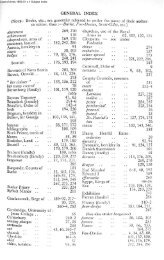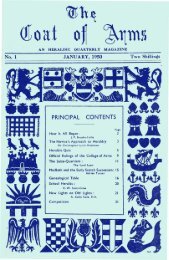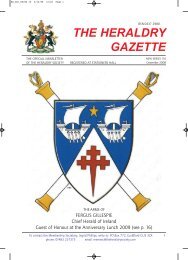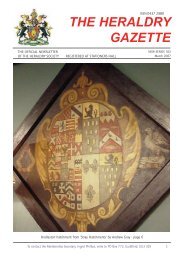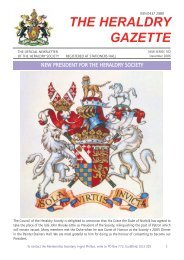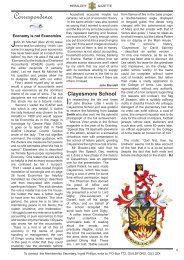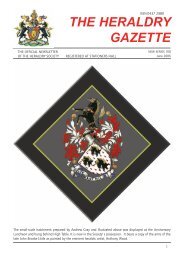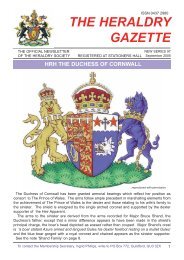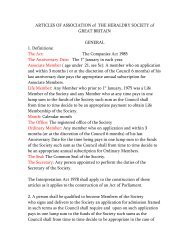Jun-09 Issue (Page 1) - The Heraldry Society
Jun-09 Issue (Page 1) - The Heraldry Society
Jun-09 Issue (Page 1) - The Heraldry Society
You also want an ePaper? Increase the reach of your titles
YUMPU automatically turns print PDFs into web optimized ePapers that Google loves.
14<br />
Amongst the London<br />
Guilds the Worshipful<br />
<strong>Society</strong> of Apothecaries is<br />
the only one to feature a<br />
rhinoceros in its arms. In<br />
the grant of 1617 the<br />
blazon is:<br />
Arms: Azure Apollo the<br />
inventor of physic proper<br />
with his head radiant<br />
holding in his left hand a<br />
bow and in his right hand<br />
an arrow Or supplanting a<br />
serpent Argent.<br />
Crest: A rhinoceros<br />
proper.<br />
Supporters: Two<br />
unicorns Or armed and<br />
unguled Argent.<br />
To my knowledge, no<br />
one has yet found any<br />
documentation to explain why<br />
the rhinoceros was chosen by<br />
the heralds to be the crest in<br />
the <strong>Society</strong>’s coat of arms.<br />
<strong>The</strong> rhinoceros featured in<br />
the arms is Durer’s rhino of<br />
1515. <strong>The</strong>re is an original<br />
engraving framed and on<br />
display at Apothecaries Hall on<br />
the Landing. This has a second<br />
and much smaller horn<br />
protruding from between its<br />
shoulder blades on its back<br />
which is often portrayed when<br />
the arms are drawn. Durer had<br />
not seen the living animal and<br />
worked from someone else's<br />
description of it - hence this<br />
erroneous second horn. <strong>The</strong><br />
following excerpt from T H<br />
Clarke’s book <strong>The</strong> Rhinoceros<br />
from Durer to Stubbs 1515-<br />
1799 (1986) is of note:”We<br />
know that Durer shared with<br />
many of his age in the<br />
fascination of the exotic; and<br />
we know of his close<br />
relationship with the<br />
THE APOTHECARIES ARMS<br />
armourers of Nuremberg.<br />
<strong>The</strong>se two facts are answer<br />
enough as to why he made the<br />
woodcut. For the exotic, Durer<br />
wrote in his notebook after his<br />
journey to the Netherlands in<br />
1520-1, where he saw for<br />
himself a group of Mexican<br />
works of art, that they were all<br />
much fairer to behold than any<br />
marvel.<br />
Given the armoured nature<br />
of Durer’s rhino and the fact<br />
that heraldry originated with<br />
armoured knights it is<br />
tempting to conjecture that<br />
the image may thus have<br />
come to the notice of the<br />
College of Arms and was then<br />
chosen as a novelty exotic<br />
creature. Exotic beasts and<br />
oriental designs (eg<br />
chinoiserie) were in vogue in<br />
the decorative arts from the<br />
beginning of the 16th century<br />
onwards as a result of travels<br />
and voyages to the then ìweird<br />
E-mail the editor at gazette@theheraldrysociety.com<br />
and wonderfulî foreign<br />
parts of the globe. <strong>The</strong>y<br />
were frequently used in<br />
designs for all sorts of<br />
household and other<br />
items such as household<br />
furniture and clocks.<br />
Similarly, the association<br />
with the perceived<br />
medicinal properties of<br />
the rhino horn may have<br />
influenced the herald<br />
responsible for designing<br />
the <strong>Society</strong>’s arms. It may<br />
also have been felt<br />
appropriate to blur the<br />
distinction between rhino<br />
horns and unicorn horns<br />
(in truth, narwhal tusks or<br />
teeth). This is because the<br />
two supporters in the<br />
<strong>Society</strong>’s armorial<br />
bearings are unicorns, James<br />
VI’s favoured beasts in his<br />
Scottish royal arms which he<br />
brought south on becoming<br />
James I, and both types of<br />
horns were considered useful<br />
as drugs when finely ground.<br />
<strong>The</strong> first live rhino to be seen<br />
in London was at the Belle<br />
Sauvage Inn on Ludgate Hill in<br />
1684 - only a bow's arrow<br />
from Apothecaries' Hall.<br />
<strong>The</strong>re is the suggestion that<br />
Durer's rhino looks armoured<br />
because the description he<br />
used was of an animal that<br />
was actually dressed in<br />
armour, and that this is also<br />
why there is a "second horn".<br />
<strong>The</strong> story and this theory is<br />
expounded in Glynis Ridley's<br />
book entitled “Clara's Grand<br />
Tour. Travels with a<br />
Rhinoceros in Eighteenth-<br />
Century Europe” (2004). <strong>The</strong><br />
Indian rhino in question (not<br />
Clara, who was a different



